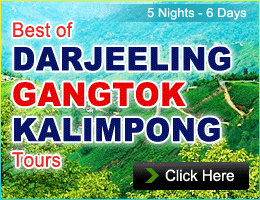- The Kingdom of Bhutan is nuzzled in the eastern Himalayas, north
of India and south of Tibet. Not only is it in the mountains, it is
virtually all mountain. The country ranges in elevation from about
600 feet to 24,778 feet, and only 8% of the land is tillable.
- Flying in on the exclusive airline, Druk Air, is the only way for
travelers to
 get there. It has a fleet consisting of two 72-passenger airplanes
and has the distinction of being the only airline to routinely fly
over eight of the tallest peaks in the world. The word Druk means
Dragon. Druk Yul is what Bhutanese call their country, translated as
the 'Land of the Thunder Dragon'.
get there. It has a fleet consisting of two 72-passenger airplanes
and has the distinction of being the only airline to routinely fly
over eight of the tallest peaks in the world. The word Druk means
Dragon. Druk Yul is what Bhutanese call their country, translated as
the 'Land of the Thunder Dragon'.
- Bhutan is known as one of the top ten bio-diversity hot spots in
the world, with an estimated 165 mammal and 5,500 plant species, 500
of which are considered medicinal. There are about 770 bird species.
- Bhutan is known as one of the top ten bio-diversity hot spots in
the world, with an estimated 165 mammal and 5,500 plant species, 500
of which are considered medicinal. There are about 770 bird species.
- 72% of the Kingdom is covered with forests. A remarkable 26% of
the entire country is protected by national parks and sanctuaries.
Most of the giant peaks have never been explored by westerners and
are considered home to the deities, so climbing them is not allowed.
Bhutan is so protective of its environment that killing a
black-necked crane means life imprisonment. Plastic bags are
illegal.
- In many ways, Bhutan epitomizes both the dual qualities of
protection and vulnerability. Nestled in the Himalayas, the country
is virtually all mountain. The highest peaks are considered sacred,
and have never been climbed by westerners. Some of the country has
not been mapped. In part because of this inaccessibility, Bhutan has
never been colonized. The only foreign invasions they've faced have
been from their Tibetan neighbors to the north, and those wars have
been fought with bows and arrows. Until recently, one village
considered itself protected because it was surrounded with cactus.
There were virtually no roads until the 1970s. Their rivers are
neither dammed nor diverted.
- The king reports their most important product of the country is "gross
national happiness." The king of Bhutan, His Majesty Jigme
Singye Wangchuck, is respected both internationally and at home. In
his 26-year reign he's been credited with opening Bhutan to the
visitors for the first time. Bringing in travelers and trekkers is
one thing, but delivering Bhutan to the 21st century is quite
another.
- Bhutan's resources are as vulnerable as they are impressive. It
has a population of about 650,000 people, most of whom are scattered
in remote valleys narrowly wedged between high mountains. It
measures 180 miles long and 100 miles wide, a land mass about
one-fifth the size of Oregon. The majority of people live on
subsistence farming with an average annual income of $510.00.
- Starting in 1999 and for the first time ever, Bhutanese were
required to pay income tax. Roads have been built within the last 20
years, and though they connect some regions, most of the country can
only be reached by footpath. In order to be cautious with its
capacity to absorb visitors, Bhutan's annual tourist count is about
7,000. There are domestic conflicts with the Nepalese immigrant
population. Major earthquakes have been rocking the region, and
scientists predict more to come.
|
 get there. It has a fleet consisting of two 72-passenger airplanes
and has the distinction of being the only airline to routinely fly
over eight of the tallest peaks in the world. The word Druk means
Dragon. Druk Yul is what Bhutanese call their country, translated as
the 'Land of the Thunder Dragon'.
get there. It has a fleet consisting of two 72-passenger airplanes
and has the distinction of being the only airline to routinely fly
over eight of the tallest peaks in the world. The word Druk means
Dragon. Druk Yul is what Bhutanese call their country, translated as
the 'Land of the Thunder Dragon'. 




